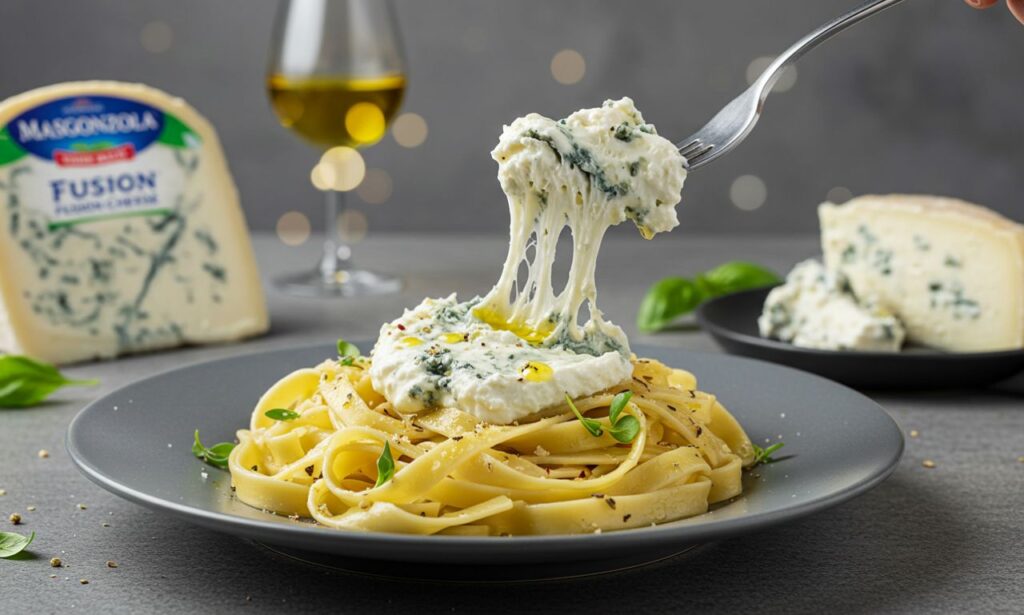In the world of gourmet cheeses, a new hybrid is quietly stealing the spotlight. Masgonzola, a creative fusion of mascarpone and gorgonzola, offers a uniquely bold yet mellow experience. This innovative cheese blend is capturing the attention of chefs, foodies, and even lifestyle influencers for its rich flavor, spreadable texture, and versatile uses. It’s not just a cheese—it’s a movement celebrating contrast and creativity.
Masgonzola isn’t just another name in the dairy aisle; it’s a symbol of culinary evolution. Combining the gentle creaminess of mascarpone with the robust, blue-veined character of gorgonzola creates a balanced, decadent result. But the story of Masgonzola is more than a tale of two cheeses—it’s a narrative about flavor harmony, visual appeal, and cultural symbolism.
What Exactly is Masgonzola?
At its core, Masgonzola is a semi-soft, marbled cheese that blends two iconic Italian cheeses: mascarpone and gorgonzola dolce. Mascarpone is known for its smooth, buttery texture, while gorgonzola brings the sharp, moldy bite typical of blue cheeses. When combined in the right proportions—typically two parts mascarpone to one part gorgonzola—the result is creamy with streaks of pungency that add complexity and intrigue.
What makes Masgonzola fascinating is not just its taste, but its adaptability. It melts beautifully into sauces, spreads effortlessly on crackers, and pairs wonderfully with sweet or savory ingredients. Its taste lands somewhere between luxurious and daring, offering something for both cheese novices and aficionados.
A Modern Cheese with Classic Roots
Though relatively new in global markets, Masgonzola has roots in Italy’s Lombardy region, where both mascarpone and gorgonzola originated. Artisanal cheese makers began experimenting by mixing soft cheeses to soften the punch of blue varieties. Eventually, the perfect blend emerged—a balanced, two-cheese hybrid now celebrated as Masgonzola.
Its rise to culinary fame has been organic, driven by small-batch producers, food bloggers, and chefs eager to explore new flavor territories. The name itself—a portmanteau of its components—reflects its duality and ease of recognition.
Flavor and Texture: A Perfect Union
Masgonzola’s appeal lies in its taste and mouthfeel. Upon first bite, you encounter the cool, rich softness of mascarpone. Then, as you savor, the earthy, piquant notes of gorgonzola begin to emerge, adding depth. The cheese is smooth, creamy, and slightly crumbly in areas with blue mold veining.
Its flavor can be described as:
-
Creamy but never bland
-
Tangy but not overwhelming
-
Nutty with a whisper of sweetness
-
Mildly pungent, offering character without dominance
This unique profile makes it a star in both elegant hors d’oeuvres and casual snacks.
Culinary Uses of Masgonzola Cheese
Versatility is one of Masgonzola’s strongest suits. Here’s how you can incorporate it into your kitchen:
1. Appetizers and Spreads
Spread it over crusty bread, crostini, or crackers and top with fig jam, sliced pears, or crushed walnuts. The contrast of creamy cheese with sweetness and crunch is irresistible.
2. Pasta and Risotto
Masgonzola melts beautifully into a velvety sauce. Add a spoonful to freshly cooked fettuccine, or stir it into risotto for a gourmet touch. It pairs especially well with mushrooms, spinach, or roasted butternut squash.
3. Gourmet Pizza
Swap out traditional mozzarella with dollops of Masgonzola on flatbreads. Add arugula, caramelized onions, or pancetta for added flavor layers.
4. Salad Enhancer
Crumbled Masgonzola adds creamy tang to salads. Try it with spinach, strawberries, toasted almonds, and balsamic glaze.
5. Elevated Burgers and Sandwiches
Spread it on buns or swirl into aioli to bring bold sophistication to your sandwiches.
6. Sweet Pairings
Masgonzola’s creamy-tangy profile works surprisingly well in desserts. Pair it with roasted fruits, drizzle with honey, or include in cheesecake for a daring twist.
Nutrition and Health Considerations
Masgonzola, like most cheeses, is best enjoyed in moderation. However, it does offer some nutritional benefits:
-
Calcium & Phosphorus: Essential for bone health
-
Protein: A valuable source of complete protein
-
Healthy fats: Especially from grass-fed varieties
-
Probiotics: Natural blue mold may support gut flora
Be mindful, though, of sodium content, especially if you’re sensitive to salty foods. A tablespoon of Masgonzola contains around 80-100 calories, making it a rich yet manageable indulgence.
Where to Find Masgonzola
Although it’s still a specialty item, Masgonzola is gaining traction. You can typically find it:
-
At high-end grocery stores or cheese counters
-
In farmer’s markets with artisan cheese vendors
-
Through online gourmet retailers
-
Or, make your own by mixing mascarpone with mild gorgonzola at home!
DIY Masgonzola Recipe at Home
Want to try it yourself?
Ingredients:
-
200g mascarpone
-
100g gorgonzola dolce
-
A pinch of salt and optional honey
Instructions:
-
Blend the cheeses until smooth.
-
Adjust the ratio for more tang or creaminess.
-
Let sit for 1 hour in the fridge for flavors to marry.
You now have your own Masgonzola spread ready for use!
Masgonzola as a Lifestyle Concept
Beyond the kitchen, Masgonzola has become a metaphor in design and art circles. The term “Masgonzola aesthetic” is now used to describe creative contrast—the merging of soft and hard, light and dark, tradition and innovation.
Designers reference it in:
-
Interior décor (industrial textures mixed with soft fabrics)
-
Fashion (structured jackets over flowing dresses)
-
Music (classical instrumentation paired with lo-fi beats)
The idea? Harmony through contrast. Just like the cheese.
Masgonzola in Pop Culture
Food bloggers, TikTok chefs, and Instagram influencers have embraced Masgonzola. Hashtags like #MasgonzolaMood or #BoldCreamyFusion accompany recipe videos and food styling posts.
Its rise parallels other artisan fusion trends—like butter boards and whipped feta—giving Masgonzola a spot among the top creative food trends.
Challenges with Masgonzola
No trend is without its challenges:
-
Limited availability in mainstream markets
-
Short shelf life due to fresh mascarpone base
-
Mislabeling risks in unregulated markets
However, increased demand is driving innovation in packaging and distribution. We may soon see Masgonzola tubs next to ricotta and goat cheese in major supermarkets.
Conclusion
Masgonzola is more than just a fusion cheese—it’s a celebration of flavor, texture, and creativity. It defies tradition by blending creamy and pungent, smooth and sharp, mellow and bold. Whether enjoyed on a cheese board, swirled into risotto, or discussed as an aesthetic philosophy, Masgonzola invites us to embrace duality and innovation.






